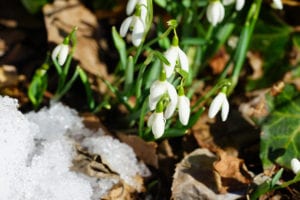The signs of spring have come to my part of the world in Minnesota. We’ve had a string of 40+ degree days and the snow has melted, at least for now. The ice has melted on the Mississippi River in front of my house. I live about a mile above a river dam, so it freezes in the late fall and opens again in early March. When the ice melts on the river, it is another sign that spring is coming. Today we are having our second day of soaking rain, which will bring new growth that hopefully shows in the next week or so.
This is the time of year that I start walking my gardens to see what new growth is emerging from the frozen soil. It is a little too soon for me to see what is coming out of hibernation, but over the next four to six weeks new growth will start appearing. This urge to walk around my gardens makes me reflect on what will emerge from our long pandemic winter as well.
COVID-19 has created a forced hibernation for all of us.
In the spring I remember where plants are located in my garden. I know where to look for the early bulbs or returning perennials, but there are also surprises. Where have the squirrels dug up and destroyed the bulbs? What new seeds have blown into my patch of dirt on the wind? What new seedlings will take root from my oak trees? These are all possibilities that I will notice and adapt to as my garden comes back to life.
Noticing is an essential skill for seeing what is emerging.
Last week I wrote a blog on reframing our expectations as a New Emergent instead of a new normal. Today, I want to suggest that noticing and being present are two new capacities we must cultivate to help this new emergent become visible. I am present and mindful when I tour my gardens, so I can notice the nuances of what is happening in front of my eyes. I don’t overlay my garden design on the soil, and therefore only notice what is supposed to be there. Instead, I notice what is and what is starting to emerge in real-time.
There is power in noticing without preconceived ideas. There are many things that have shifted and will continue to evolve as we slowly come out of the pandemic. We have to stop embracing perceptions that are familiar or predictable and refrain from observations based on past patterns. Instead, we need to look at what’s happening through a completely clear lens.
To really see the new emergent we need to cultivate our ability to notice what is actually happening.
I invite everyone to notice more as spring emerges after a long, isolated pandemic winter. I would love to hear your answers to the questions:
- What are you seeing?
- What is surprising or unexpected?
- What patterns are taking new forms?
- What didn’t make it through the winter?







Just noticing that YES! magazine’s latest issue on ecology promotes ideas of human ecology as well. You are probably already aware. I’m glad the concept is spreading and that you continue to extend it 🙂
As signs of spring emerge in nature as a parallel to a spring from the Covid 19 pandemic. I notice many of the signs of spring, ice melting to water, longer daylight and the warmth and intensity of the sun. It is a slow process which requires patience (it can snow in March or April). Every day there is movement to a spring emerging from a winter of pandemic. I am making plans to see loved ones again (we are vaccinated) and we traveled for spring break and yet I am reminded to be patient as we emerge to a new spring. There is a slow cadence to emergence for some things. I like the idea of a new emergent versus new normal. I don’t think I want “normal” . New emergent sounds way more fun, promising and interesting. I wonder how I would experience/describe it if we began emerging from the pandemic in the fall versus spring.
I took a recent run that I hadn’t done for over a year and noticed a newly paved street and my local shoe repair shot has reopened. He’s quite the cobbler and still enjoys my stopping my run and telling him a few jokes.